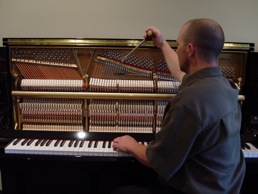Pitch corrections are performed to bring the piano back to A=440Hz, the international pitch standard. Pitch corrections are often needed to correct the pitch of the piano because of fluctuating humidity levels. Occasionally the correction is done to lower the pitch (spring and summer months – at times of high Relative Humidity (RH)); other times the correction is needed to raise the pitch (winter months – times of low RH). More frequently, however, pitch corrections are performed to bring a neglected piano back to standard pitch. If your instrument has not been serviced in over a year, regardless of how much use it has received, you can expect that it will require a pitch correction.
In dramatically volatile climatic conditions, pitch corrections may be required if the instrument goes more than a couple of months without service. While this is not typical, it can and does happen. In extreme cases, it may be necessary to perform more than one pitch correction to bring a piano back to standard pitch.
The process of pitch correcting is little more than a very fast, rough tuning. The technician, for the most part, completes the entire process of tuning but does not concentrate on getting the notes sounding “just right.” The goal of the pitch correction is to get the tension on all of the piano’s strings very close to their proper tension at A=440. This is the only way to achieve a truly fine-tuning on a piano, and one of the reasons that performance instruments are serviced so frequently.
In general, a piano will resist a change in pitch (tension) by approximately 25%, on average, due to the increased load on the support structure of the piano. For example, if a piano is 4Hz flat (A-436), and a normal tuning sequence is followed, the end result will be a piano that is still approximately 1Hz flat (A-439). This phenomenon is frequently compensated for during the pitch raise process by using a technique called “overpull.” Essentially, overpull is the process of pulling the strings somewhat above their target pitch so that when the process is completed, the overall tension drop will result in the strings being very close to the target pitch. Why not just tune the piano “where it lies?” Tuning to anything other than A=440 is rarely appropriate. Like a car, a piano is a major investment, and a complex machine that deserves to be properly serviced.
How can you avoid costly Pitch Corrections?
One way is to have your piano tuned at least once a year – though every 6 months is better. There are still no guarantees as to how close to pitch your piano will stay, but the more frequently the piano is tuned, the closer it will stay to standard pitch. An even better way is to install a Piano Life Saver humidity control system in your piano. The Piano Life Saver is designed to create a micro-environment around your piano and maintains a constant Relative Humidity (RH) regardless what time of year it is, or what nature is doing. Pianos that I service with humidity control are more closely in tune at an annual appointment than the same piano without humidity control, seen every six months.



